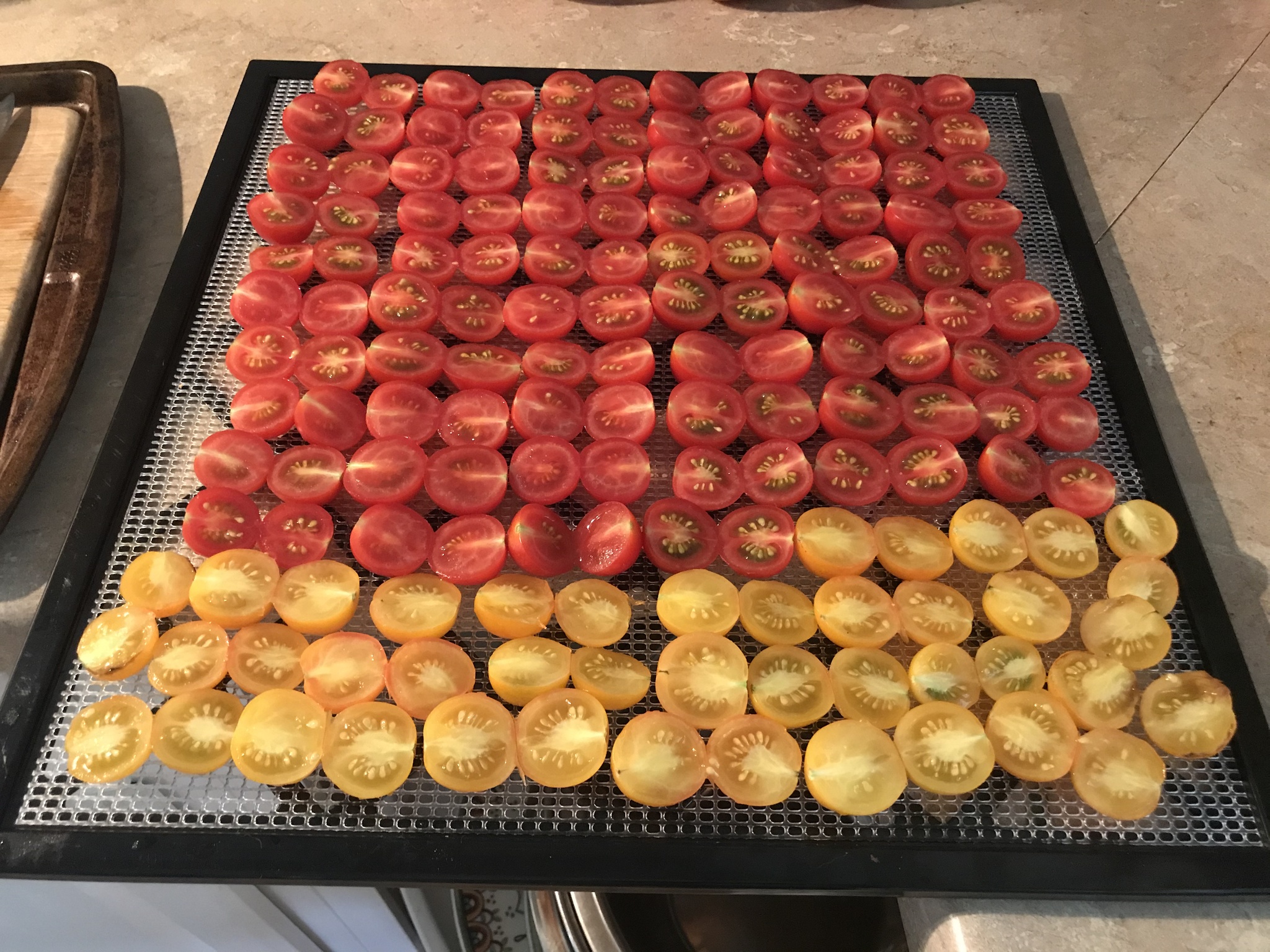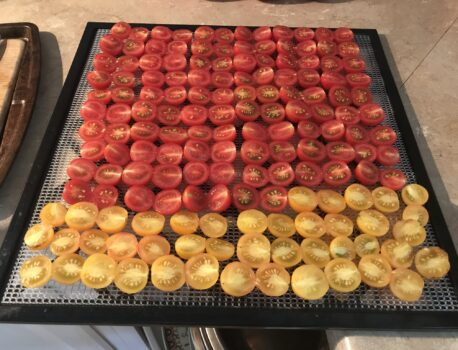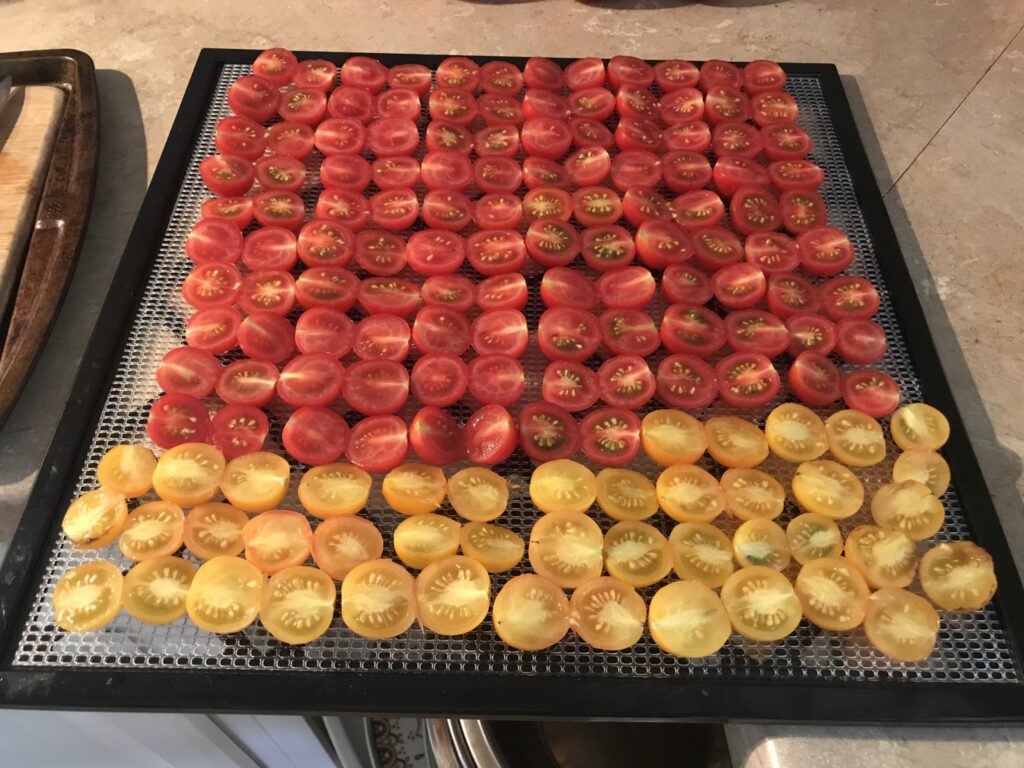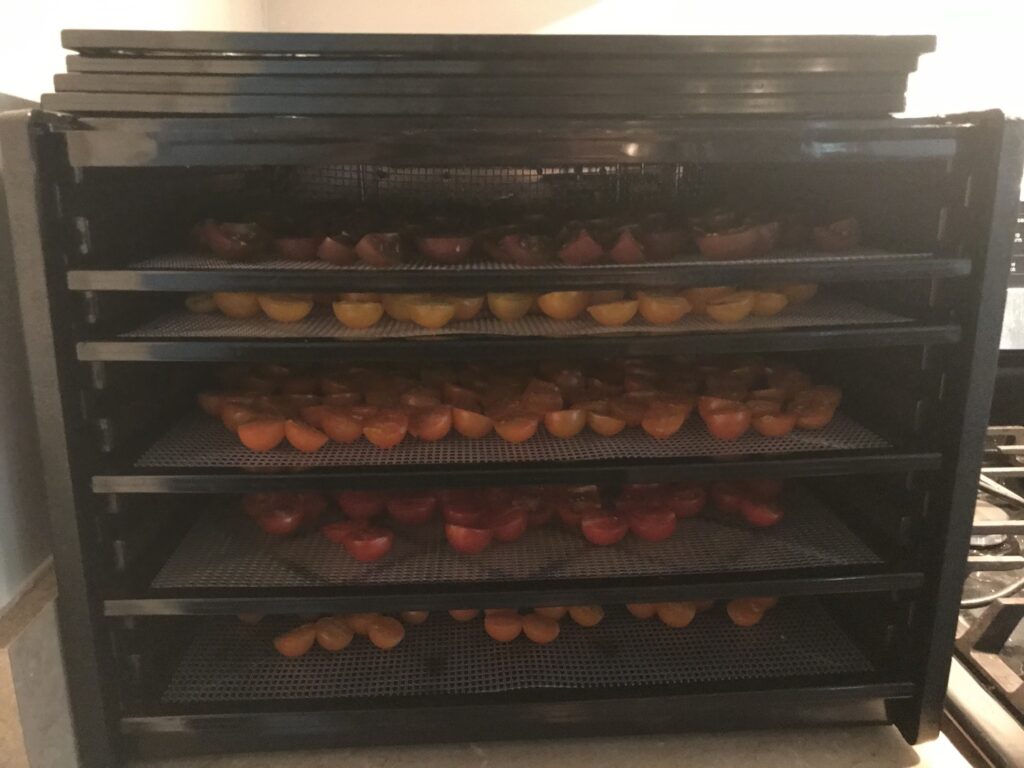This is the time of year when I realize that my winter eyes were bigger than my summer stomach. At the height of the August heat I curse myself for planting so many tomatoes. (Canning in 90 degree heat in a kitchen with no AC is less than pleasant.)
Come winter (right around the time crop planning season begins), I’m so glad that I have a variety of items to choose from to remind me of the summer’s abundance. This post focuses on the four ways I like to preserve tomatoes including:
- Freezing
- Canning
- Dehydrating
- Storing Green
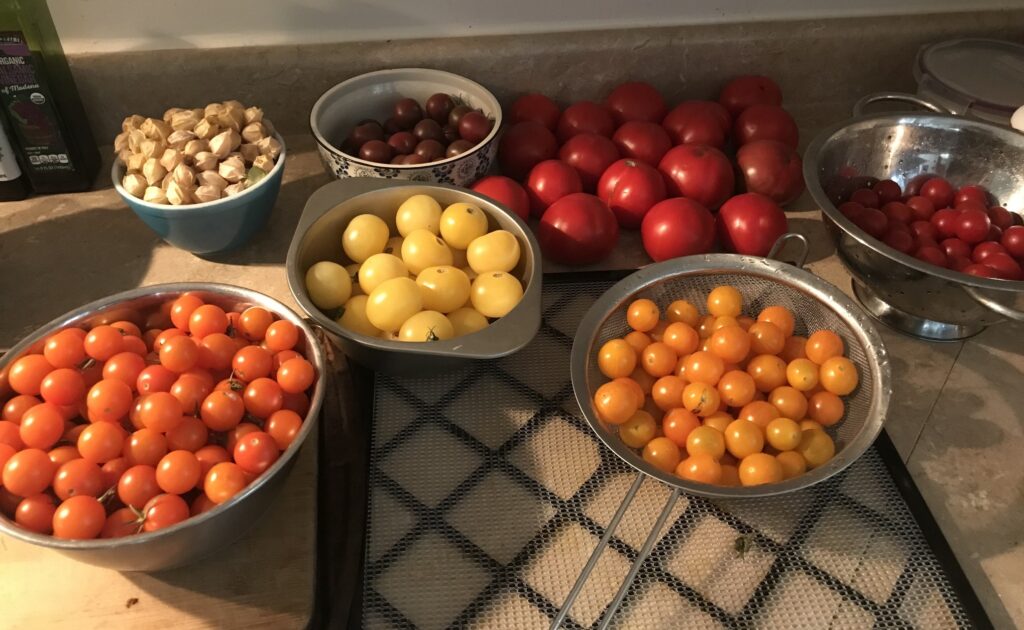
1) How to Freeze Tomatoes
This is the easiest way to deal with a glut of tomatoes. I dice and freeze without deseeding or skinning my tomatoes. If you want yours seed/skin-free you’ll have to take an extra step (see below).
What you need to freeze tomatoes:
- Quart-size freezer bags
- Permanent marker/Sharpie
- Serrated bread knife
- Cutting board
- Cookie sheet
- Large bowl
Quick Steps for Freezing Tomatoes:
- Place your cutting board on a cookie sheet to catch runaway juices to keep from making a mess of your counter.
- Dice tomatoes and put them in a large bowl. I find a serrated bread knife to be the best tool for this job.
- Spoon into freezer bags.
- Label with date and any other relevant information.
2) How to Can Tomatoes
I won’t go into a ton of detail here because the how to can depends heavily on what recipes you use. Please just note that it requires special equipment and recipes.
I like Jill Winger’s explanation of canning.
Canning for a New Generation is a great resource with amazing recipes if you enjoy having a book to work from in the kitchen.
You always want to follow a trusted recipe when canning. This is one of those situations where you don’t want to stray from what’s on the page. Successful canning requires specific acid/sugar levels plus adequate time at high heat in order to create a vacuum seal. This is what allows preservation for 1+ years.
What you need to can tomatoes:
- Water bath or pressure canner
- Clean mason jars with new lids
- Two large bowls for coring and deseeding
- Two pots, one with boiling water
- Trusted canning recipes
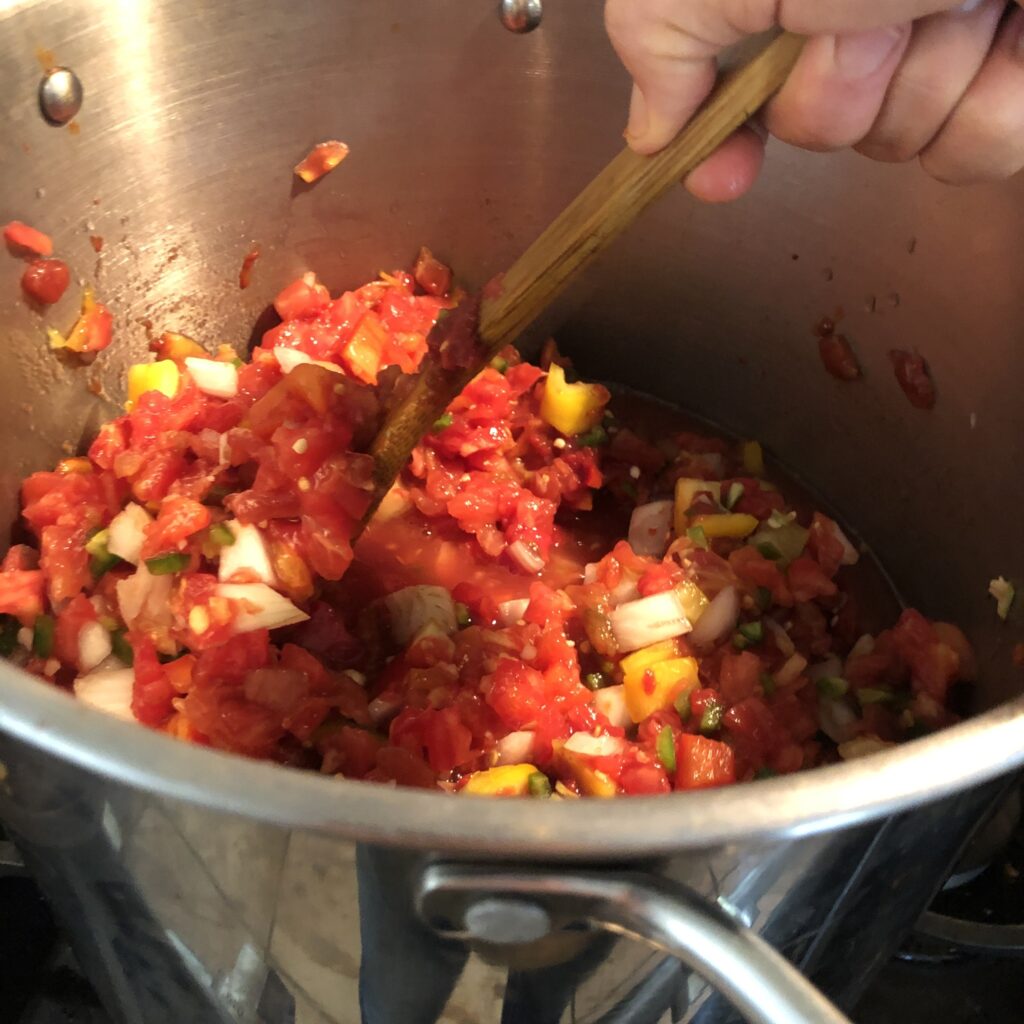
Skinning & Seeding Tomatoes
- Score the tomatoes by making an ‘X’ on the blossom end
- Place them in a pot of boiling water for 15-25 seconds or until the skin has split around the ‘X’ (don’t leave them in for more than a minute or else they’ll begin to cook)
- Remove the tomato and plunge in a bowl of ice water to stop the cooking process and facilitate peeling.
- Once cooled, peel the skin off by hand or with a knife. It should peel off effortlessly.
- Cut the tomato in half and remove seeds with a small measuring spoon. (I actually don’t bother with this step and just stick my fingers into the pockets containing seeds. It gets pretty messy and the tomatoes don’t hold their shape as well but I chop and cook them right away so that matters less.)
3) How to Dehydrate Tomatoes
This is a great way to get that sun dried tomato flavor and is my favorite way to preserve the seemingly endless and totally overwhelming supply of cherry tomatoes.
Drying tomatoes in a dehydrator:
- Wash and de-stem tomatoes.
- Slice tomatoes into small pieces to speed up the drying process. Cut cherry tomatoes and half and slicing tomatoes just under ½ inch slices (anything thinner will not dry evenly or will not come off in one piece). Cherry and Roma/paste tomatoes tend to work the best. If you do attempt to dry larger tomatoes, consider coring them first.
- Season as desired with salt and herbs (this step is optional… I find them to be perfectly sweet and delicious without seasoning).
- Lay tomatoes out evenly on your dehydrator screens, cut side-up. Make sure they are not touching.
- Set dehydrator to 130-150 degrees F and dry for 6-10 hours. Drying time will depend on temperature, size, and moisture content of your tomatoes. Tomatoes should be leathery and dry to the touch. (You may remove some and leave others in a bit longer until they’re all evenly dry.)
- Store them in an air-tight jar/container in the cupboard or fridge. If you store them in the cupboard, make sure to shake the tomatoes around once a day for about five days in order to release any excess moisture to prevent molding. Some people store them in olive oil to extend their shelf-life.
excalibur dehydrator
Dehydrating tomatoes in the oven:

- Wash and de-stem tomatoes.
- Slice tomatoes into small pieces to speed up the drying process. Cut cherry tomatoes and half and slicing tomatoes just under ½ inch slices (anything thinner will not dry evenly or will not come off in one piece). Cherry and Roma/paste tomatoes tend to work the best.
- Season as desired with salt and herbs (this step is optional… I find them to be perfectly sweet and delicious without seasoning).
- Lay out tomatoes evenly on a cookie sheet lined with parchment paper, cut side-up. Make sure they are not touching.
- Set oven to 225 degrees F for 5 hours. Drying time will depend on temperature, size, and moisture content of your tomatoes. Tomatoes should be leathery and dry to the touch. (You may remove some and leave others in a bit longer until they’re all evenly dry.)
- Store them in an air-tight jar/container in the cupboard or fridge. If you store them in the cupboard, make sure to shake the tomatoes around once a day for about five days in order to release any excess moisture to prevent molding. Some people store them in olive oil to extend their shelf-life.
4) The Best Way to Store Green Tomatoes
When I rip out my tomato plants at the end of the season I harvest most of the large green tomatoes. I make a healthy batch of fried green tomatoes and then store the rest in a crate with newspaper/paper bags in the coolest part of my house (basement).
While these aren’t the most flavorful tomatoes you’ll ever eat, they’re still better than store-bought tomatoes and having them in December is a lovely treat.
- To keep fresh tomatoes into winter, wrap them individually in newspaper and store in a very cool place (40-50 degrees F). This slows the ripening process and allows you to hold them longer. Some people have had success storing them until January! Mine never seem to last that long…
- To ripen your green tomatoes earlier, leave them in an open crate/box lined with newspaper or leave them on the counter. To hasten ripening, place a banana in the box. Bananas, like tomatoes, release ethylene gas as they ripen which causes the other ethylene-sensitive foods around them as well.
Best Tomato Varieties for Processing
I process all tomatoes regardless of variety but I do grow certain varieties specifically for canning.
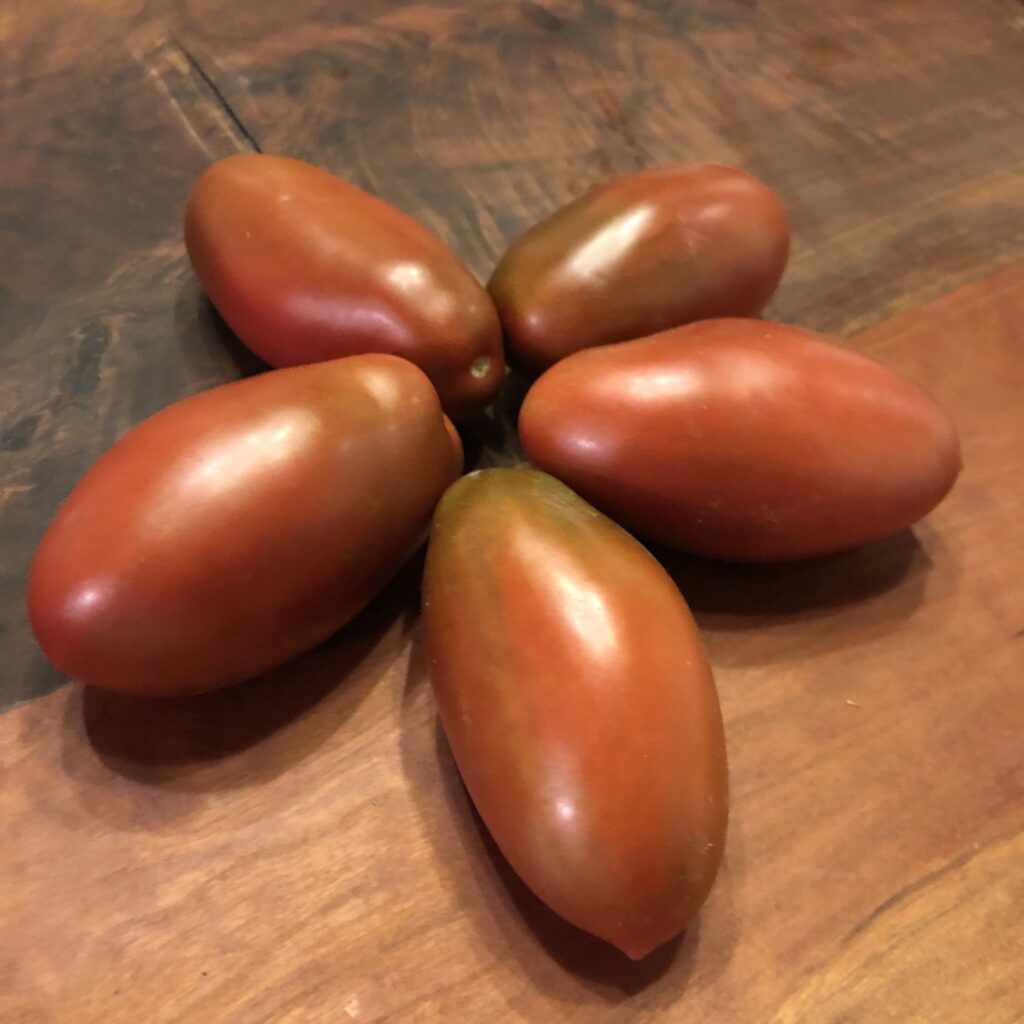
- Romas/Paste tomatoes are the best for preserving, especially for making sauces and salsas. San Marzano and Black Icicle are my go-tos.
- Slicers are the next best as they tend to hold up well for dicing. New Girl and Big Beef are my favorites. I use them in chili and stews.
- Heirlooms tend to be the juiciest and mushiest and are less ideal for preserving. I always freeze Striped Germans and Cherokee Purples because they are a delicious reminder of summer. I use them to make soups.

